The 2022-2023 Digital Learning Design Working Group supported faculty in developing innovative learning experiences for their students.
Funded by the Academic Technology Advisory Board, the working group brought together eight faculty from a variety of disciplines for 10 working sessions over the course of the year.
Participants spent the fall designing and testing their projects before implementing them in their spring courses. The spring semester sessions provided time for group members to reflect on what they were learning from seeing their projects in action.
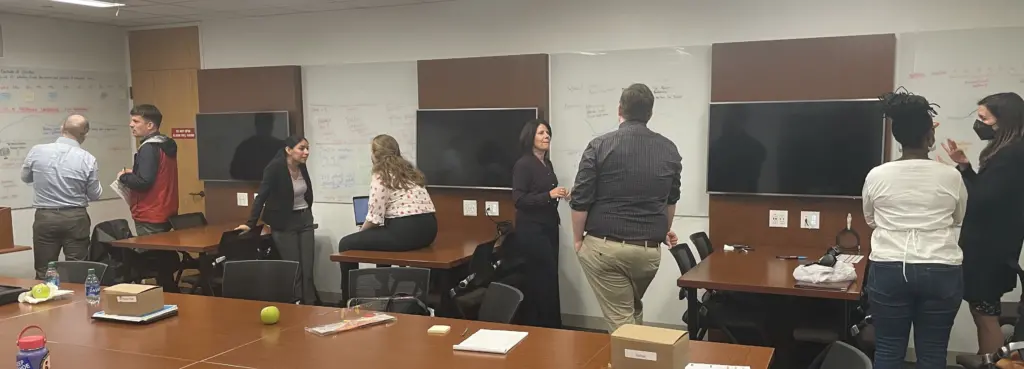
Participant Projects
Holly Deak: Interactive Organic Chemistry Flashcards
Holly Deak, Associate Professor of the Practice in the Chemistry Department of the Morrissey College of Arts and Sciences, joined the Working Group with the goal of providing students with a novel learning tool in a course whose “reputation precedes it”– Organic Chemistry.
Holly and her colleague, Professor of Chemistry, Marc Snapper, had previously worked together on a project developing an online short course for students to take in the summer prior to their enrollment in organic chemistry that gives them exposure to some of the foundational topics and concepts they need for success in the course.
As part of the Working Group, Holly, in continued collaboration with Marc Snapper, intended to expand upon the resources available to the students by developing an application designed to build students’ working knowledge of key functional groups, or atoms or groupings of atoms in molecules with characteristic properties and reactivity. Through this application, students gain experience recognizing and identifying functional groups in organic molecules with relevance to their lives, such as flavor, fragrance, and drug molecules, giving students the confidence they need to “jump into complex problem solving later in the course.”
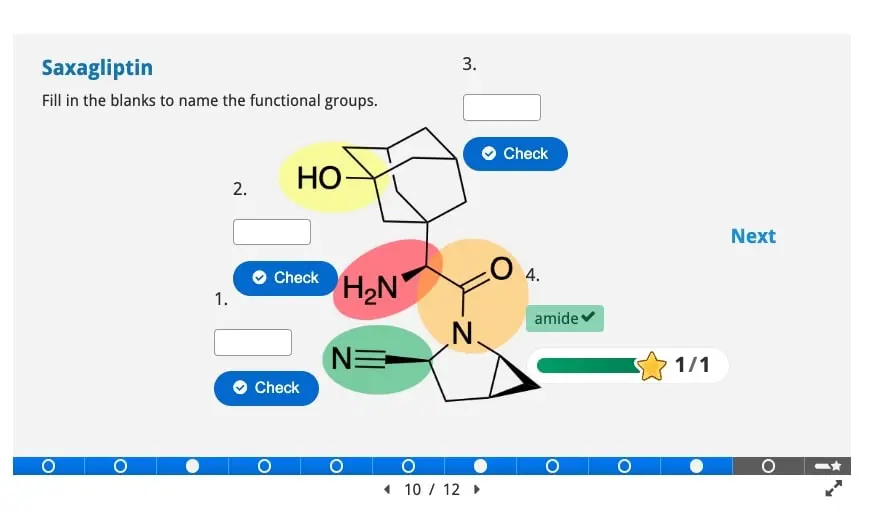
Holly points to the structure of the Working Group’s format, the support she received from CDIL, and the community with a “variety of colleagues from different disciplines” as the most valuable aspects of her participation.
Before joining the working group, Holly said she “didn’t know what the capabilities were in terms of technology in making this project come to fruition,” and was delighted by the way that CDIL staff were “so willing to help [each Working Group member] make these ideas come to life in a way that was best suited for our individual problems and courses.”
“I looked forward to the meetings,” Holly said, because “having the opportunity to share our ideas in a discussion-driven format was so valuable because everyone has a different way of looking at best serving students.”
Holly plans to continue to develop this project, and has already applied for further grant funding. Because of her experience in the Working Group, she says, “I feel empowered to make that happen in an independent way with student input.”
Lynn DiBenedetto: Interactive Clinical Case Studies
Lynn DiBenedetto, Associate Professor of the Practice in the Biology Department of the Morrissey College of Arts and Sciences, cited her commitment to learning and drive to always “better the classroom experience by allowing students to engage more fully” as key to her desire to participate in CDIL’s Design Thinking Faculty Working Group.
In her upper level biology course, Lynn had long been frustrated with the realization that much of the information that students should come into the course knowing due to previous coursework, they simply don’t remember or are unable to apply to novel situations.
Instead of taking lecture time to review this information, Lynn decided to “create interactive clinical case studies in which students could reacquaint themselves with prior, basic biological concepts and apply them to these real cases.”
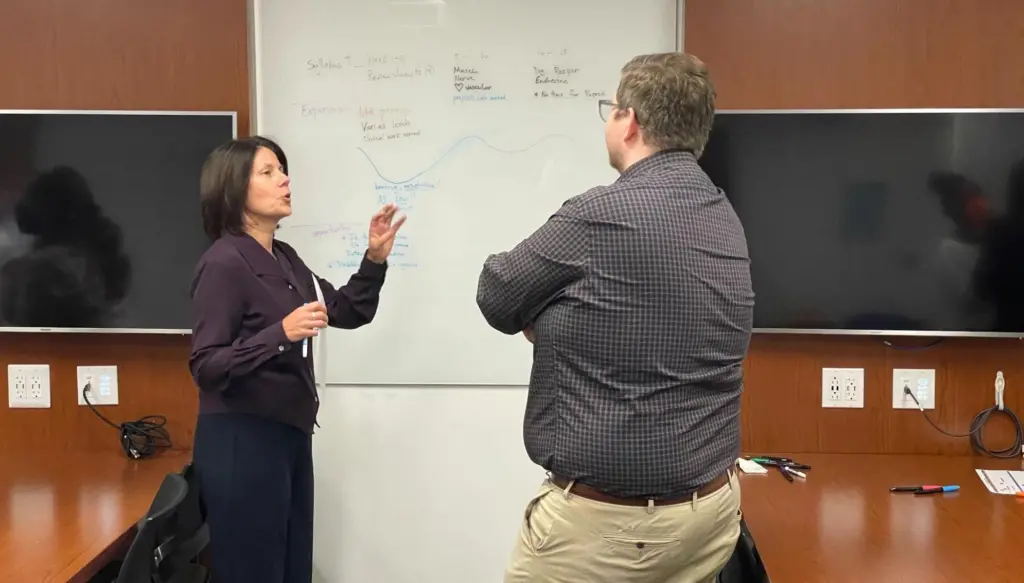
Lynn credited the diverse and collaborative environment of the Working Group as central to what she was able to create. She said,
“I have thoroughly enjoyed seeing such a diverse group” and spoke about “seeing how [different faculty members] come up with solutions” prompted her to always ask herself, “Oh, could I do it that way?”
Lynn also spoke about how her experience of working with CDIL over the pandemic gave her an appreciation for the design process and the value of approaching pedagogy from a team-based approach. Initially, she said, she, along with other faculty bristled at the ideas of having deliverables and firm due dates for course development. “I said, ‘That’s a business model! We do not work like this!’” However, through conversations with people outside of the academy and her experience working with the staff at CDIL, her perspective changed. “I learned how to work with a design team. I learned to let go and use people who have far more skills in certain areas.” This collaborative approach has reioriented her approach to pedagogy.
When reflecting on the regularity of the Working Group Meetings and the value of having dedicated time and space to think about design and pedagogy with others, Lynn said that she’ll initially think, “Ah! I have so much to do… but once I’m there, this is my happy place.”
Madison Dunaway: Creating an Inclusive Makerspace
Madison Dunaway, the Manager of Design and Prototyping within the Office of the Vice Provost for Research, decided to join the Design Thinking Faculty Working Group with a specific issue in mind. What could be done, she wondered, to address the trend that her team was seeing in terms of the difference between the number of people who take BC’s Makerspace (“The Hatchery”) Orientation and then the ultimate number of users who come back to actively use the space? “We want to make sure that they’re coming back,” said Madison, “and the Makerspace Orientation is the first opportunity they have to interact with the Makerspace.”
While Madison said that she initially felt a bit out of place as a full-time staff member in a Working Group where the title specifically says “faculty,” she came to realize that the problem she was looking to solve was the same one that other participants in the group were also grappling with– learning retention, which then prompted her to reflect more deeply about the shape of learning in non-traditional academic spaces on campus.
This project of breaking down barriers between learning that happens in more formal academic settings, like the classroom, and those outside of the classroom walls, connects directly to Madison’s overarching concern with fostering inclusion and access in her work. Emphasizing the value of the space created by the Working Group to have intentional discussions about accessibility and inclusion, Madison emphasized the extent to which the Working Group experience leads to valuable insights and projects that directly benefit many students. She said,“There’s not a lot of dedicated space created in my world right now for doing the things we need to do to create intentional access and really focus on inclusion,” but that the Working Group creates “such a safe space to talk about user experience… and to talk about what students are really feeling when they’re in these learning spaces.”
Madison initially joined the Working Group to revamp the Makerspace Orientation, but she said that her participation has ultimately led to her “dreaming bigger because [she] realizes that there is the support to do that” at Boston College. “If I did not have CDIL’s help in this, our Makerspace Orientation would probably be a Google form,” Madison shared. She continued, saying that her participation in the Working Group “really makes me think, ‘What is the next thing we can do to make this idea even more incredible for our users?’”

Underscoring the value of “celebrating iteration and failure” that is central to Design Thinking, Madison spoke about a new idea that was generated from the Working Group–bookable design consultations for users. “I wanted to have [the Design Consultations] be something that physically manifest[s] in the space that you can book,” she shared. The current iteration of bookings is about 80% students and 20% faculty members.
Madison also points to the relationships she was able to build through her participation in the Working Group as being one of the most valuable aspects of her participation, not only for fostering a sense of greater connection to the BC community but also for the way that those relationships can help facilitate future collaborations and efforts to bridge academic and non-academic departments on campus, all for the benefit of Boston College students.
Rhonda Frederick: Supporting Multimodal Projects
Rhonda Frederick, Professor of English & African Diaspora Studies in the Morrissey College of Arts and Sciences, is passionate about inspiring “the predominantly white students [at BC] to think about black literature in a different way and to use this thinking to rethink the [English] major.”
In her course, “Black Women’s Writers and the Question of Form,” Rhonda asks students to question how ideas and themes in black literature work as “tools” through which all of us can imagine selves and social worlds differently.
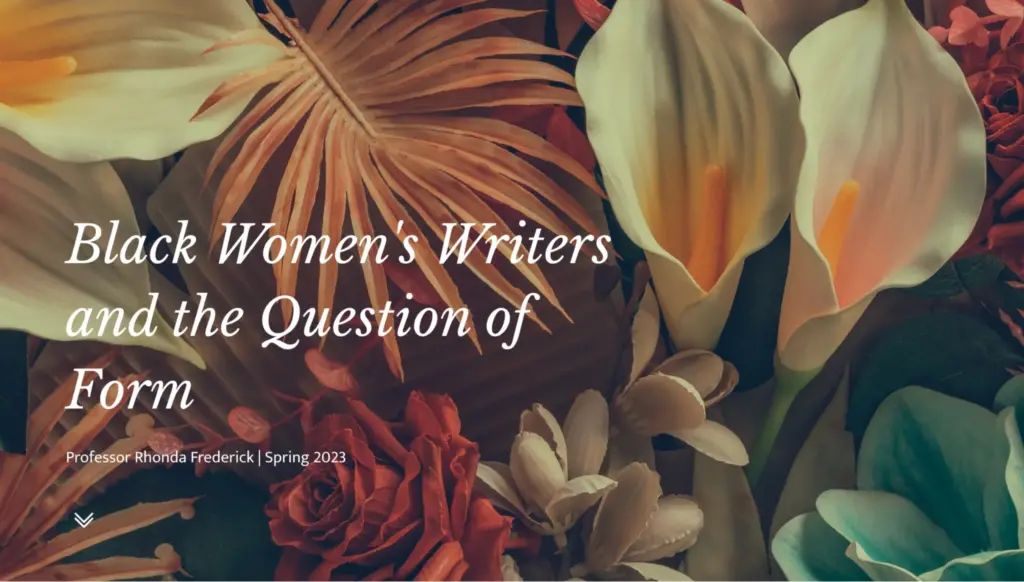
In the Working Group, Rhonda worked on prototyping different ways to showcase student project work connected to this class– both for the pedagogical purpose of pointing current students to exemplars created by previous students, but also to tangibly demonstrate the exciting, generative work being created by students through their engagement with black literature.
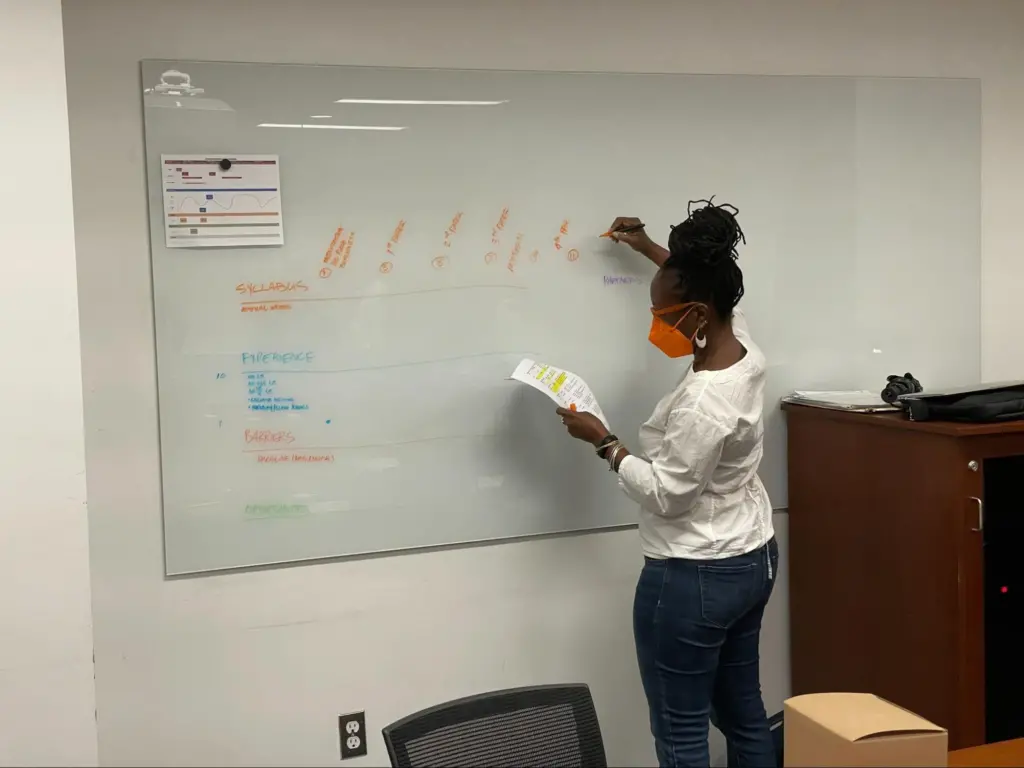
Rhonda described her experience in the Working Group as “amazing” and “exciting.” “Just being in that space and hearing how other people made it happen for them, you start thinking about things you don’t know or ideas you don’t have and this opens you to new possibilities. The more you sit with [these ideas] and think about [them], the more it all becomes possible,” Rhonda reflected.
Yohana Gil Berrio: Podcasting for Language Learning
Yohana Gil Berrio, Assistant Professor of the Practice of Hispanic Studies and Coordinator of the Upper-level Spanish Language Program, was excited to join the Design Thinking Faculty Working Group both because of her interest in technology and also because as a relatively new faculty member, she saw her participation as a chance to get to know more about the resources on campus available to faculty members.
Yohana thinks that the language classroom, in particular, has much potential for innovative uses of technology, especially for the way that it can push students to use their language skills in authentic ways.
Yohana credits her participation in the Working Group with helping her to move from the space of ideas to tangible outputs for her classroom. Yohana said that she came into the Working Group with many “general ideas” of what she wanted to accomplish, but that she “didn’t know how to make those ideas a reality in the classroom.”
The relationships built in the Working Group, as well as the community fostered through regular meetings, resulted in a type of faculty development experience that she has yet to have in her over eleven years of teaching at different universities. Because of this “supportive community,” Yohana shared, she was able to receive feedback from others, including a variety of resources to strengthen her pedagogy.
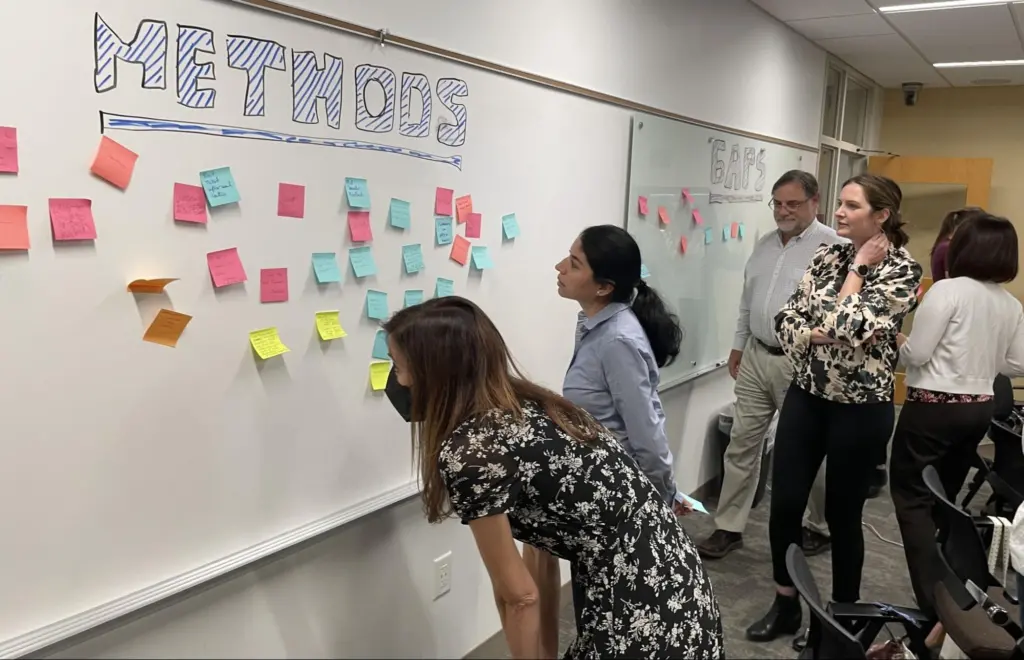
The Design Thinking framework helped Yohana to constantly circle back to the foundational question driving her work– What is the gain for students in terms of language learning and their experience? She also highlighted the importance of the Design Thinking process in making her feel comfortable with iteration and failure saying that, trying different methodologies, external learning tools and applications, ” and figuring out that “not everything worked” led her to “completely change” her original idea and instead shooting for an in-class experience for her students that she never would have imagined could be possible at the onset of her participation in the Working Group.
With the support of CDIL, Yohana, along with a colleague, Ali Kulez, applied for and received a generous grant from the Institute of Liberal Arts to bring prominent podcaster, Daniel Alarcón, to campus. Yohana said, “given the substantial amount of time devoted to the analysis of Radio Ambulante’s podcasts within the classroom setting, I believed it would be highly advantageous for students to engage in direct interaction with the co-founder, executive producer, and host of that Spanish-language podcast distributed by NPR,”
but she wasn’t sure if this goal of hers could come to fruition as he’s a very popular public figure. “Everything started because I was in the Design Thinking group,” Yohana said.
Joseph Nugent: An AR Experience of Ulysses
Joesph Nugent, Professor of the Practice in the English Department of the Morrisey College of Arts and Sciences at Boston College, entered the Working Group with a goal to create a new, updated version of the digital project, JoyceWays: Ulysses for You. The first iteration of the project launched about a decade ago on June 14, 2012, in conjunction with Bloomsday, an annual celebration of James Joyce.
A team of undergraduate students, including Cyrus Rosen (MCAS ‘25) and Nina Khaghany (MCAS ‘24) have been working on developing an Augmented Reality version of the app, using the spatial publishing platform, Hoverlay. The goal of the project is to use the technology to create a walking tour of Dublin for two of the chapters in Ulysses, Chapter 1: Calypso and Chapter 2: Lestrygonias.
Rosen, joined the project after taking Professor Nugent’s Ulysses course with the tagline, “read it if you dare.” Speaking of Nugent’s leadership style, Rosen highlights Nugent’s ability to “bring the right people together to get things done.”
Khaghany speaks to the potential for the project to make Ulysses, a notoriously challenging text, accessible to a wider public saying, “It’s revolutionizing the way that you can teach the book.” As a double major in English and Classics, Khaghany connects with Joyce as a “lover of words.” Khaghany is motivated to take what has historically been available only to the elites, such as learning Latin or reading Ulyssess and democratizing that knowledge, saying, “It’s about taking something and giving it to others… What’s the point of having knowledge if you’re not sharing it?”
Jeremiah Potts: Experiments in Engagement
Jeremiah Potts, Lecturer in the Management and Organization department of the Carroll School of Management, has long prioritized experiential learning in classes. One example is his long-running debate in his Strategic Management course.
As exciting as students found the debate, Jerry remained unsatisfied because not only did he notice that not everyone was speaking during the debate, but often the participation by some students felt “perfunctory,” as if students were thinking to themselves, “I get my point, and I raised my hand, and I did it twice.”
Through his participation in CDIL’s Design Thinking Faculty Working Group, Jerry was able to “reimagine participation” and engagement for his class– both for students and in terms of his role as a faculty member.
As a faculty member, Jerry highlighted the crucial connection between feeling connected as a faculty member and the quality of the student learning experience that faculty can cultivate for students. “For me,” Jerry shared, “the big thing is, I think sometimes you can get isolated in your approach to teaching.” He continued, “For the students, the more connected we are as faculty and the more we can reinforce and understand and feel that we are a part of something, that creates a better experience for [students]… To be sitting there [in the Working Group] with biochemistry and English folks and see what is being done makes you realize that even though each class is teaching different things, the pain points and the opportunities to engage students are very much the same.”
Foregrounding his goal to create a sense of community and engagement in his classroom, Jerry spoke about the role that technology played in helping him to improve the student learning experience. He shared how through his participation in the Working Group, he’s learned to see how Design Thinking, technology, and pedagogy work in tandem. “Design Thinking helps you to come up with the concept, and the technology layers on top of it,” Jerry said. He learned “how to take the technology and not get caught up in the buzz of any technology, but to see it as a tool to connect.”

Jerry feels that he achieved success at reimagining what participation looked like in his classroom, and credits his working relationship with members of CDIL as providing the motivation and “enthusiasm” for his project in moments where he felt like he was “floundering.”
“It’s like having a paid consultant helping you out for free!” Jerry said laughing, something which he notes is “unheard of in the business world.”
Jon Wargo: Podcasting as Educational Scholarship
Jon Wargo, Assistant Professor in the Teaching, Curriculum, and Society Department in the Lynch School of Education and Human Development, entered the Designing Digital Learning Experiences Faculty Working Group with a plan– he wanted to refresh “The Artifact Assignment,” a “staple assignment” for his first-year doctoral seminar, transforming this foundational assignment into a podcasting project.
“The Artifact Assignment,” asks students to analyze an educational artifact through the lens of its educational purposes, as well as to discuss what this artifact might communicate about the history of curriculum or educational thought. Professionally, it also prepares students for the work of giving a conference paper.
Jon’s choice of podcasting, as a mode and medium of communication, was purposeful for its potential to bridge the gap between conversations about education in the academic world, in the realm of policy, and in the wider community.

Bringing with him into the working group some previous experience with Design Thinking through his engagement with studio arts, Jon initially thought that students would be most concerned and focused on the technical aspects of the project and spent time thinking clearly about how to break down each stage of the project for students into fifteen-minute mini-lessons. However, he found himself surprised to find that students were not concerned about technology at all. Rather, they were worried about whether or not their choice of artifact would “count.”
“You can almost feel the fear that they have that they’re going to fail, which I think is going to limit some of the risks that I wish people would take,” Jon shared.
Jon points to one particular moment in the classroom when a student asked him to clarify that what he was looking for was “proof of concept,” inspiring him to expand his notions of what is possible moving forward. “If proof of concept is the bar, I think I could have pushed it further.”
A sense of expansive possibilities for the potential of student work and creative insight from learning more about the work of his colleagues across the campus is what Jon highlighted as the most valuable aspect of his participation in the working group. Pointing to the work of other faculty members, particularly that of Joe Nugent in the English department, Jon shared that he now has a different idea of what is possible, which might have allowed him to spend more time in the ideation phase of the Design Thinking process, “throw[ing] spaghetti at the wall and see[ing] what sticks.”
“I love the cross-community collaboration. I think that the university works, unfortunately, in really siloed ways,” Jon shared about his participation in the Working Group.
Ultimately, Jon takes with him from this experience not only many ideas for how he might change this project in the future, but with a sense of energy and excitement surrounding the next time he has students podcast in the classroom saying, “I want to move forward and do it again.”
If you are interested in learning more about the Center for Digital Innovation and Learning or partnering with us in designing a learning experience, feel free to get in touch.
